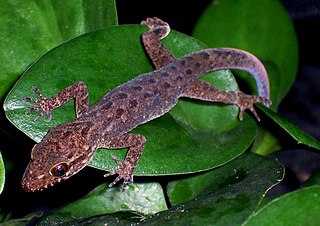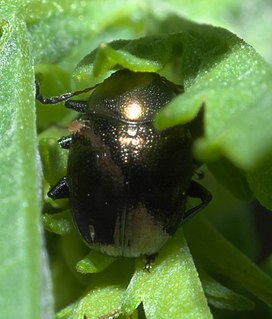Related Research Articles

Cyrtodactylus is a diverse genus of Asian geckos, commonly known as bent-toed geckos, bow-fingered geckos, and forest geckos. The genus has at least 300 described species as of 2020, which makes it the largest of all gecko genera.

Mealybugs are insects in the family Pseudococcidae, unarmored scale insects found in moist, warm habitats. Many species are considered pests as they feed on plant juices of greenhouse plants, house plants and subtropical trees and also act as a vector for several plant diseases. Some ants, however live in symbiotic relationships with them.

Cherax is the most widespread genus of fully aquatic crayfish in the Southern Hemisphere. Together with Euastacus, it is also the largest crayfish genus in the Southern Hemisphere. Its members may be found in lakes, rivers, and streams across most of Australia and New Guinea. In Australia, the many species of Cherax are commonly known as yabbies. The most common and widely distributed species in Australia is the common yabby. It is generally found in lowland rivers and streams, lakes, swamps, and impoundments at low to medium altitude, largely within the Murray–Darling Basin. Common yabbies are found in many ephemeral waterways, and can survive dry conditions for long periods of time by aestivating in burrows sunk deep into muddy creek and swamp beds. In New Guinea, Cherax crayfish are found widely in rivers, streams, and lakes, with a particularly high diversity in the Paniai Lakes. New Guinea is also home to the only known cave-living crayfish in the Southern Hemisphere, C. acherontis. Some species are very colourful and sometimes seen in the freshwater aquarium trade.

Aiphanes is a genus of spiny palms which is native to tropical regions of South and Central America and the Caribbean. There are about 26 species in the genus, ranging in size from understorey shrubs with subterranean stems to subcanopy trees as tall as 20 metres (66 ft). Most have pinnately compound leaves ; one species has entire leaves. Stems, leaves and sometimes even the fruit are covered with spines. Plants flower repeatedly over the course of their lifespan and have separate male and female flowers, although these are borne together on the same inflorescence. Although records of pollinators are limited, most species appear to be pollinated by insects. The fruit are eaten by several birds and mammals, including at least two species of amazon parrots.

The Platycnemididae are a family of damselflies. They are known commonly as white-legged damselflies. There are over 400 species native to the Old World. The family is divided into several subfamilies.

Myotis fimbriatus is a species of vesper bat in the family Vespertilionidae. It is found only in China. It's also called the fringed long-footed myotis. The fringed long-footed myotis is described as having short, thick, brown fur with pale whitish fur ventrally. A captured female was measured with ears that were 14.4 mm long, a forearm 42.2 mm long, and a weight of 9.9 grams. Myotis fimbriatus is listed as being of least concern by the IUCN as of 2008. In 2000, Myotis fimbriatus was listed as being "lower risk/near threatened".
Putoidae is a family of scale insects commonly known as giant mealybugs or putoids. There is probably a single genus, Puto, containing about sixty species. The genus name Macrocerococcus has also been used but it is now considered to be a synonym of Puto. The genus Puto was formerly classified as a member of the Pseudococcidae; however, it so significantly differed from the rest of the Pseudococcidae that it was accorded its own family Putoidae.
Giraudia may refer to any of several biological genera:
Gouxia danielaferreroae is a species of mealybug that lives in France. It was placed in a monotypic genus by Lucien Goux in 1989, but the genus name he used, Giraudia, was a junior homonym of at least two other animal genera. The genus was renamed Gouxia in his honour in 2009.
Nematocharax is a genus of freshwater fish in the family Characidae. It contains the single species Nematocharax venustus, which is endemic to Brazil, where it is found in the Jequitinhonha River basin. The males of this species can reach a length of 5.1 centimetres (2.0 in) SL while the females only grow to 3.5 centimetres (1.4 in) SL.
Peritelini is a weevil tribe in the subfamily Entiminae.
Hyalinobatrachium dianae, also known as Diane's bare-hearted glass frog, is a species of Costa Rican glass frog in the family Centrolenidae.
John Stuart Noyes is a Welsh entomologist.

Eumolpini is a tribe of leaf beetles in the subfamily Eumolpinae. It is the largest tribe in the subfamily, with approximately 170 genera found worldwide. Members of the tribe almost always have a longitudinal median groove on the pygidium, which possibly helps to keep the elytra locked at rest. They also generally have a subglabrous body, as well as appendiculate pretarsal claws.
Trabutina mannipara, or mana scale, is a species of mealybug found in the Middle East and southern Europe. It is the most well-known of the five species in the genus Trabutina, of which it is the type species, due to its association with the biblical story of manna. T. mannipara feeds parasitically on tamarisk trees, and excretes a sweet substance which is sometimes collected for human consumption. Obsolete terms for it include Coccus manniparus and Trabutina palestina. This species can be found in the Sinai and Iraq.
Trabutina is a genus of "blue-green" mealybugs, containing five species: T. crassispinosa, T. elastica, T. mannipara, T. serpentina, and T. tenax. This genus of scale insects feeds solely on plants of the genus Tamarix. Its type species is T. mannipara.
The Taiwan broad-muzzled myotis is a species of vesper bat found in Taiwan.
Submyotodon is a genus of vespertilionid bats, published as a new taxon in 2003 to describe a Miocene fossil species. Extant species and subspecies previously included in Myotis were later transferred to this genus.
Solariola is a genus of weevils in the family Curculionidae. The genus is endemic to Italy.
References
- ↑ Kaydan, MB (2015). "A systematic study of Peliococcus Borchsenius (Hemiptera: Coccoidea: Pseudococcidae), with descriptions of a new Palaearctic genus and four new species from Turkey". Zootaxa. 3920 (2): 201–48. doi:10.11646/zootaxa.3920.2.1. PMID 25781247.
- ↑ "Valid Names Results". scalenet. Retrieved 3 April 2018.
| | This article related to members of the insect superfamily Coccoidea is a stub. You can help Wikipedia by expanding it. |